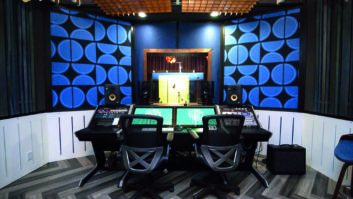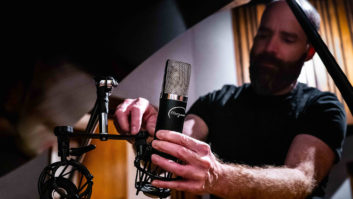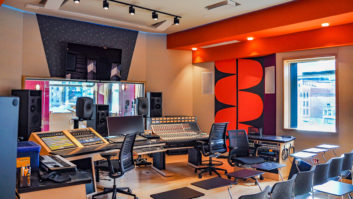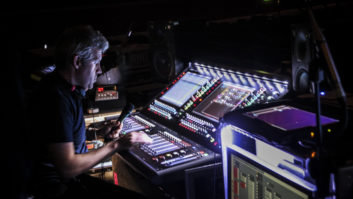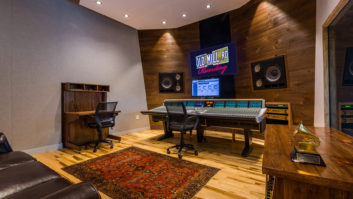AEA R88 and R88A Ribbon Mic

The R88A ribbon microphone is an active version of AEA’s R88MK2 Passive Ribbon Mic. Like the R88MK2, the R88A is a stereo microphone with two ribbon motors stacked on top of each other and off-set. The R88A offers an extra 12dB of transformer gain, which is advantageous when recording quiet sources like vocals or soft acoustic guitars. The active impedance buffers help prevent noise interference on long cable runs or when operating near large lighting rigs. The R88A requires standard 48V phantom power to operate.
AKG Lyra

The AKG Lyra delivers acoustically transparent, 4K-compatible, Ultra HD-grade 24-bit/192 kHz audio resolution. It features the AKG Adaptive Capsule Array, providing four optimized capture modes that makes it easy to deliver professional sound for any application. Plug-and-play operation allows creators of all experience levels to get set up with and start recording quickly, while easily accessible controls provide complete control. An internal self-adjusting shock mount minimizes contact noise, while a built-in sound diffuser and AKG’s proprietary Internal Element Overload Prevention automatically reduces noise, eliminates pops and improves signal levels.
The AKG Adaptive Capsule Array uses four capture modes to adapt to performances automatically. Front mode isolates the target sound from distracting background noise by rejecting unwanted sounds at the microphone back and sides. Front & Back mode captures and blends together sound equally on all sides. Tight Stereo mode captures audio in true stereo with discrete left and right audio. Wide Stereo mode captures audio with greater stereo separation, room ambience and depth.
Audio-Technica 5047

Audio-Technica’s AT5047 condenser microphone has a capsule that features four rectangular diaphragms delivering their output via transformer-coupled circuitry. The AT5047’s four diaphragms function as a single, large membrane, but because each is smaller than a single membrane of the same surface area, they react faster to transients. Electronically summing the output of the diaphragms enables the AT5047 to maintain the quick transient response of a small-diaphragm capsule while achieving the low self-noise (6 dB) of a large-diaphragm. The AT5047’s pickup pattern is fixed-cardioid.
Audix
Audix introduced a number of new mics at Winter NAMM, including the the A131 and A133 fixed charge condenser models, and the A135 and A137 true condenser models. All four models have internally shock mounted cardioid capsules. The A133 and A137 are equipped with pad and roll off switches.
The A160 is a transformer-based, passive, bidirectional ribbon microphone with no active electronic components, and is based on the classic ribbon design and does not require phantom power.
The A127 is a type one reference microphone with a 1/2-inch metal film omnidirectional capsule.
Austrian Audio OC818

Austrian Audio is introducing the OC818 and OC18 large diaphragm microphones. Handmade in Vienna, the OC818 is a multi-pattern dual-output condenser microphone equipped with optional wireless control, while its OC18 sibling is a cardioid pattern microphone. The OC818 features a second output that allows the engineer, producer or musician to record the rear-facing capsule independently of the forward-facing capsule. At the heart of the range is the patent-pending, handmade CKR12 ceramic capsule, made to the same critical dimensions as the acclaimed CK12 capsules.
DPA 2028 Vocal Mic

DPA Microphones 2028 vocal microphone is designed for live stage performances, broadcast and pro AV applications. On a live stage, the 2028 delivers the same sonic qualities as DPA’s other solutions. The company maintains that the 2028 needs no (or very little) EQ to sound just like you are standing next to the singer listening to their performance. In addition, the transparency of the 2028 allows engineers to spend their time shaping the sound experience rather than covering up issues caused by artifacts.
The 2028 features a brand-new fixed-position capsule, as well as a specially designed shock-mount and pop filter. It exhibits a supercardioid polar pattern, with the famed DPA uniform off-axis response. This gives the microphone a very high-gain-before-feedback and makes it easier to handle bleed from other instruments in close proximity, picking up sound in a natural way.
Earthworks SR314
The Earthworks Audio SR3314 and the SR5314 wireless vocal microphone capsules are designed to bring studio clarity to the stage. The sound is achieved by coupling the small diaphragm cardioid condenser capsule with a Class A amplifier circuit that leverages Earthworks patented and proprietary technologies. Their tight cardioid polar pattern, their consistent low frequency response across a wide range of distances, and their extreme attenuation of sound sources located beyond 90 degrees—with maximum rejection at 180 degrees—makes them ideal for live performances. The SR3314 is designed to work with any handheld wireless transmitter that utilizes a standard threering concentric connector. The SR5314 is designed to work with the following from Sennheiser: Digital 9000 Series, Digital 6000 Series, 2000 Series, Evolution G4 500 Series, Evolution G4 300 Series and Evolution G4 100 Series.
Heil Sound PR 37

Heil Sound’s PR 37 professional microphone is designed with the vocalist in mind, and produces natural, articulate sound over a wide frequency range. Its upper mid-range response has been designed to cut through a mix whether live or in the studio. It features a 1.5-inch diameter dynamic element that is mounted in a rugged housing to reduce handling noise. The PR 37 has a frequency response from 50 to 18,000 Hz and output level of –51 dB @ 1000 Hz. The PR 37 will begin shipping in July. Retail price is $269 US.
Mackie EleMent Series
Mackie has launched its new EleMent Series microphones, consisting of three models: the EM-89D Live Vocal Dynamic, EM-91C Large-Diaphragm Condenser, and EM-USB USB Condenser microphones. The EM-89D dynamic microphone features a cardioid polar pattern and is primarily designed for stage use, but can double in the studio. Similarly, while it’s intended to be a handheld vocal microphone, it can also be used as an instrument and amplifier microphone. The EM-89D comes with a mic clip, XLR mic cable, and zipper pouch.
The new Mackie EM-91C’s classic cardioid polar pattern makes it flexible enough to handle a variety of studio applications. While Mackie recommends using it on stringed instruments, the microphone is also up for live streaming, voiceovers and other types of content creation. The EM-91C comes with a shock mount and an XLR mic cable.
The Mackie EM-USB condenser microphone connects directly to a laptop or mobile recording device using USB-C and features a built-in headphone output with independent volume control. It also provides controls for main input gain and mute. Included with the EM-USB are a mic clip, tripod mount, and USB-C cable.
The EM-89D carries a US MAP of $69.99; the EM-91C is priced at $79.99 US MAP; and the EM-USB is available at $149.99 US MAP.
MXL Revelation II

MXL Microphones Revelation II microphone is the successor to the company’s MXL Revelation model. The MXL Revelation II offers the warmth and intimacy of a quality tube microphone, but with extended clarity and punch for balanced recording. A dual gold-sputtered, 6 micron diaphragm and hand-selected EF86 pentode tube provide warm, rich and transparent sound.
Mojave Audio MA-1000
The MA-1000 from Mojave Audio, a companion company to Royer (with designs by founder David Royer), uses a purposebuilt transformer from Coast Magnetics, an original NOS 5840 tube, and 3-micron, 1-inch gold-sputtered capsule. Features on the power supply include continuously variable pattern control from Omni to figure-8, a highpass filter at 100 Hz (6 dB per/octave), and a switchable –15 dB pad. The mic comes with an carrying case housing the mic, power supply, Sling-Shock shock mount and cables.
Myburgh M1

Myburgh Microphones, previously Burg Microphones, has announced the availability of its first product, the M1. The large-diaphragm tube condenser microphone features a German-made Mylar M7 capsule and Russian military-grade tube. Placing a focus on durability, Myburgh claims this mic’s body and mechanics are “built to last a lifetime.”
Featuring variable polar patterns and true cardioid, the M1’s frequency response has minimal cut off below 30Hz or over 20 kHz and is “incredibly linear” according to the company. The M1’s sound comes from two custom-built transformers within the mic and power supply, combined with the German capsule and capsule basket design. The mic has the ability to withstand very high sound pressure and sports a low noise floor and high output.
Peluso P-280 Vacuum Tube Microphone

The P-280 delivers an ultra-high resolution signal, low noise-floor and vacuum tube warmth. The P-280 employs a tube/FET combination amplifier stage to achieve a quiet noise floor. The miniature pentode tube keeps the circuit’s signal warm and pleasing, never brittle or strident. It has an assertive gain level, and easily handles very high SPL sources. The body and head grille are machined brass with a black finish.
The P-280 is paired with the Peluso MX-56 power supply. The dual sided capsule in the P-280 enables the power supply to feature nine polar patterns in an array from omni-directional to cardioid to figure eight. The P-280 features a heavy-duty 8-pin screw-on cable connector. The large diameter pins in the screw-on connector give a tight and secure cable connection. Acoustically matched pairs are available upon special request.
PreSonus PX-1

The PreSonus PX-1 cardioid condenser microphone is designed for recording vocals, guitar, podcasts, and much more. A true large-diaphragm condenser microphone, the PX-1 features a 25mm, gold-sputtered capsule designed to provide clarity throughout its frequency response range. It has a cardioid polar pattern and rugged construction.
Hard mount and carrying case are included.
Royer R-10 Ribbon Microphone
The Royer R-10 is a passive mono ribbon microphone designed for use in the studio and on live stages. Hand-built in Royer’s Burbank California factory, the R-10 handles SPLs of up to 160 dB @ 1 kHz. The R-10’s compact size and mounting system allow for flexible, unobtrusive positioning. The R-10’s 2.5-micron aluminum ribbon element is formed with Royer’s direct-corrugation process and is protected by a 3-layer windscreen system and internally shock-mounted ribbon transducer. The ribbon transducer is wired for humbucking to reject electromagnetically induced noise, and the R-10’s internally shockmounted ribbon transducer isolates the ribbon element from shocks and vibrations, increasing the ribbon element’s durability.
RØDE NT-USB Mini
The RØDE Microphones NT-USB Mini is a compact USB microphone that offers studio-quality recording direct to a computer or tablet. Designed to deliver crystal-clear, professional sound in a powerful yet easy-touse package, it’s designed for gamers, podcasters, musicians, streamers, business professionals and more.
The NT-USB Mini features a studio-grade headphone amplifier and a high-quality 3.5mm headphone output, complete with precision volume control, allowing you to easily monitor your audio. There is also a switchable zero-latency monitoring mode for eliminating distracting echo when tracking vocals or recording instruments.
Its magnetic desk stand provides a sturdy base for reducing noise from knocks and bumps and is easily removable, allowing the mic to be quickly detached and placed on a studio arm or mic stand. This and the integrated 360-degree swing mount means you can position the mic upright, on an angle, sideways or upside down—wherever it needs to be to get the best recording possible. At just 89mm wide and 141mm tall, the NT-USB Mini is very compact.
Roswell Mini K87

The Roswell Mini K87 is a high-resolution condenser microphone with a neutral voicing. The mic’s sound comes from a combination of a specially tuned K67/K87-style capsule and a circuit that was designed to enhance and complement it. According to Roswell, the Mini K87 excels on vocals, guitars, acoustic strings and drum overheads. The Mini K87 ships with Roswell’s Cutaway shockmount, a Roswell-branded microfleece mic sock and an aluminum flight case.
sE Electronics Harp Blaster

The Harp Blaster HB52 dynamic harmonica microphone is a collaboration between HOHNER and sE Electronics. Based on the inspiration from a select group of professional players and modeled after the sound of legendary vintage harp microphones, the Harp Blaster HB52 is comfortable to hold, cup and use for long periods of time.
The high output level and high impedance will drive amps properly without the need for any impedance converters, boost pedals or stomp boxes. In addition to its handy dimensions, the flat and sleek grille of the Harp Blaster ensures a tight cup and facilitates powerful hand effects.
Shure TwinPlex
Designed to stand up to the toughest conditions, Shure’s TwinPlex provides natural audio at both high and low frequency when professional vocal performance is a must. The capsule technology offers best-in-class sound in an easy-to-conceal package, ideal for quick costume changes or discreetly placed under wardrobe with no impact on sound quality. TwinPlex consists of four lavaliers (TL45, TL46, TL47, TL48) and an ultralight, fully-adjustable headset microphone (TH53) in multiple colors with extensive accessories and options.
Sony C-100

The Sony C-100 is a two-way condenser microphone compatible with high-resolution audio. Incorporating newly developed double microphone capsules and noise elimination structure that was originally employed in the C-800G microphone, the C-100 delivers a frequency range of 20 to 50,000 Hz. The condenser element of the C-100 microphone provides a selectable pick-up pattern (Omni/Uni/Bi) for various recording applications.
Warm Audio WA-84
Based upon the German-made KM84, the WA-84 is a small-diaphragm cardioid condenser microphone featuring discrete Class-A circuitry and high-quality components in the audio path. A custom-made capsule spec’d by Warm and manufactured in Australia was designed to reproduce the sound of the original capsule, and the output is coupled using a nickel-core CineMag transformer. Warm’s decision to use an output transformer is a nod to the original design.

